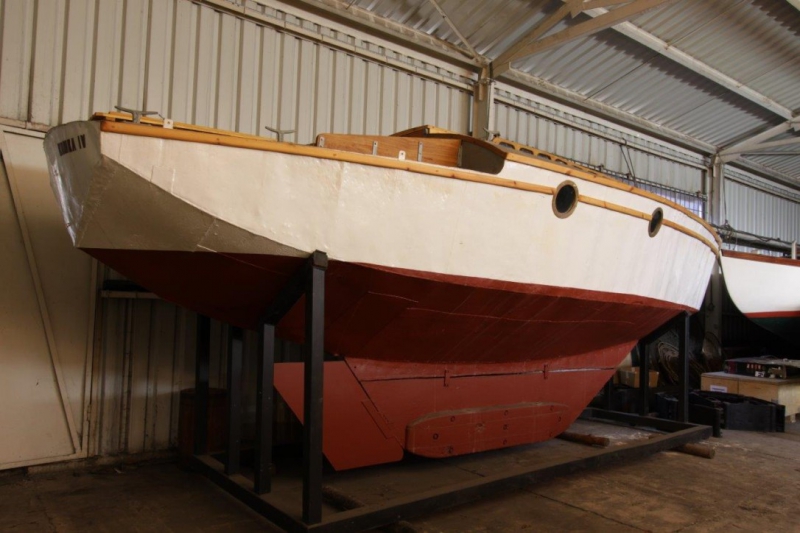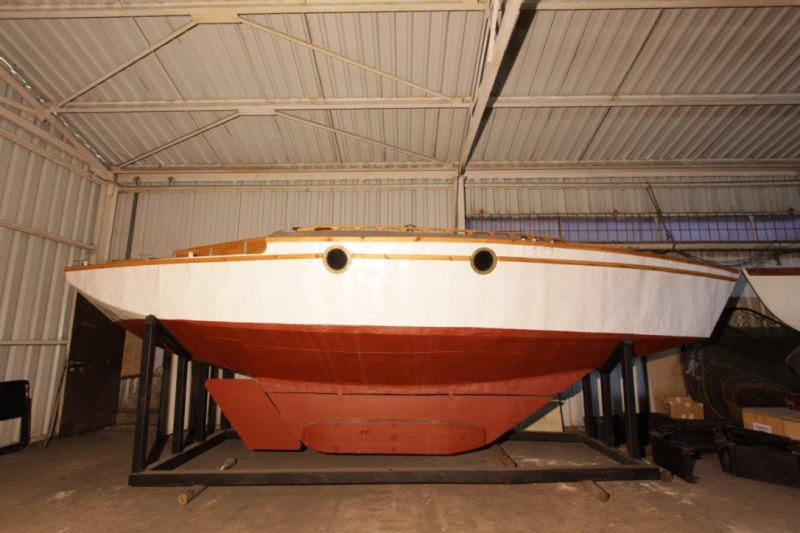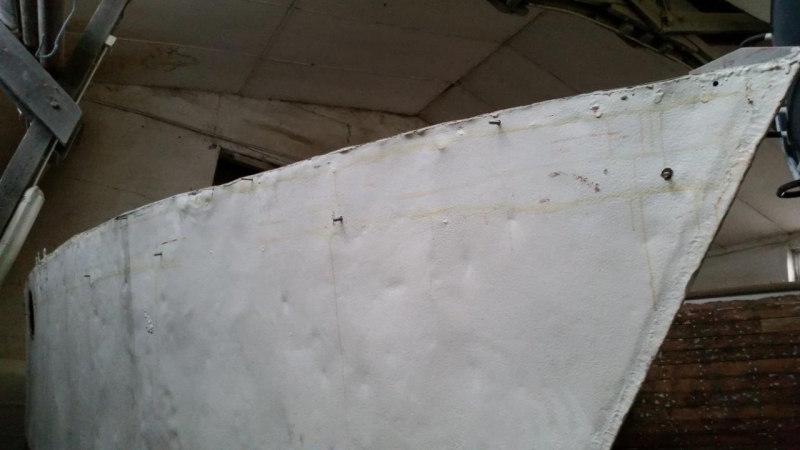Indestructible “Kumka IV”
“Kumka IV” was intended to be like a plan: fast, light, watertight, and in addition, cheap in construction, with welded metal sheets used as material. When Tadeusz Sołtyk, a 28-year-old engineer, was designing a yacht for his own use, his goal was reaching two years of her operation before she would be defeated by corrosion. “Kumka IV”, however, survived through the war and outlived her designer. In two years, she will be celebrating her 80th birthday in the Shipwreck Conservation Centre in Tczew, which is currently under construction.
Welds vs bolts
Tadeusz Sołtyk was an engineer with two passions: aviation and sailing. As an ambitious plane designer, he dreamt about designing a small tourist yacht for four people. She had to be fast, watertight, easy in conservation and cheap in construction. After all, sailing did not have to be the most expensive way of the least comfortable leisure activity, as a Polish proverb stated. Sołtyk did not want to save at all costs but he wanted to introduce innovative solutions. He considered riveting, traditionally employed in shipbuilding, to be a waste of time – after all, steel could be welded. However, an innovative idea of a young engineer did not win plaudits in sailing business – a pioneer’s life is never easy. Tadeusz Sołtyk, however, did not realize that he was a pioneer, and his design of a yacht with a 2-millimetre thick welded steel plating was an innovative idea – presumably, the first of its kind in Poland.
Original form
Sołtyk designed a chine vessel with a sloop type of rigging. Collision chamber was placed in the bow section and was separated with a watertight bulkhead, it served as a boatswain’s storage and a head. A midship cabin, fitted with heat and sound insulation, was equipped with two bunks (with luggage and water containers underneath) and was separated with units from a double aft cabin. One of the cabins was equipped with a galley which could be closed, and the other cabin had a wardrobe. A steel “C”-shaped section was installed on the bottom of the hull. The layout proved to be comfortable during the first cruise when Sołtyk sailed down Vistula to the sea and upon placing the yacht on a side, he could install a bulb keel before entering deeper waters. The helm was placed on the edge of a ballast blade. Marked 2-millimetre metal sheets were placed on an assembly carcass and then welded with gas. After that, upon turning the yacht back on the bottom, foundation of inside stiffenings was welded in. Frames were made of try squares welded to the plating with an edge of one section. Such placement of a try square provided stiffness of the plating-frames system and an easy access to all places which could become corroded. “Kumka IV” was built in a Warsaw workshop of Zgliński, Glazura and Sieradzki and at that time cost around PLN 6,500 (equipment included).
Before “Kumka IV” became “Elektra”
“Kumka IV” was sailing in the Baltic Sea for two years. During sailing regattas in Copenhagen, the vessel aroused great interest despite the fact that she did not enter the race. Everyone admired her modern shape and solutions employed in her construction. In 1939, after a minor repair and an upgrade, Sołtyk sailed to Bornholm: “Kumka IV” was faced with a storm and then with a helm damage. Right before the start of World War II, the yacht returns to Gdańsk. Tadeusz Sołtyk participated in the September Campaign. Taken prisoner in the Battle of Kock, he escaped and hid out in an estate in Brest. His yacht (renamed as “Elektra”) was used by the Germans at that time. According to certain sources, sea trials with remote control system were conducted on “Kumka IV”. Her plating was partly damaged during demolition of a breakwater in a yacht dock in Gdynia.
“Kumka IV” disappears
After the war, in 1948 the hull of “Kumka IV”, riddled by shrapnels, was purchased by Zbigniew Milewski, a yacht designer. The vessel was repaired (among others, the rigging was replaced) and sailed in the Baltic sea under the name of “Smyk” until 1950. To avoid escapes of sailors to the West, the authorities introduced a ban on sailing in the sea and therefore “Smyk” was sold to Giżycko. At that moment, the yacht’s history ended: “Kumka IV” alias “Smyk” disappeared. Every now and then, it was mentioned that a yacht, similar to Sołtyk’s one, was spotted in Masuria.
Found years later
In 2001, Mirosław Kuklik of the former Central Maritime Museum found “Kumka IV” in a shed in Białystok. As a donation of her owners, the yacht was transported to the Vistula River Museum, a department of the National Maritime Museum in Gdańsk. The hull of “Kumka IV” was corroded significantly, with damages in the plating, and the repair works required very delicate specialist techniques. Acting in agreement with Tadeusz Sołtyk (the designer of “Kumka IV” was very surprised by the discovery of the yacht) and Stocznia Żuławy in Piaskowiec near Ostaszewo, Museum conservators decided to take immediate steps in order to save this historic vessel.
Fine work
The works on “Kumka IV” started in 2003 in Stocznia Żuławy. Once rust was cleaned from the sides and the inside part of the hull, the conservators concluded that the hull was so badly corroded that some of its fragments had to be replaced. Missing fragments of metal sheeting were welded to the hull the same way as in 1937. The hull was covered with anticorrosive paints, missing elements were filled in, among others bull’s-eyes, cleats and deck finishings. A ballast blade was restored and fastened to the hull. Tadeusz Sołtyk participated in reconstruction works, conducted free of charge by the shipyard (the Museum paid only for materials), as a consultant. In accordance with his suggestions, “Kumka IV” was painted – the underwater part was painted in a lead oxide colour and the part above the waterline was painted white. The deck was covered with jute and painted light grey.
Conservation activities
Upon completion of the shipyard stage of reconstruction, “Kumka IV” was taken care of by the Museum specialists. At this stage, the support and specialist advice provided by the yacht’s designer, in particular in disputable issues arising from replacement of wooden elements (in the course of research works, it was determined that two different elements of the bow hatch coaming could be made of different kinds of wood and presumably, were replaced after the war), were invaluable. The Conservation Department reconstructed hatches, handrails, cockpit grating, benches and backrests in the cockpit, deck fastenings for jute sacks, and fenders. All works were conducted on the premises of the Vistula River Museum in Tczew, where “Kumka IV” was stored until 2014.
Freshening up in Puck
Along with other historic yachts, in the summer of 2014 “Kumka IV” was transported to Complex Jacht, a Puck based company. For the purpose of the Shipwreck Conservation Centre in Tczew construction project, this boatbuilding company is conducting repair works on “Dal” and “Opty”. The purpose of their works on “Kumka IV” is revitalization of the yacht. The repair conducted 12 years ago was of such high quality that currently the yacht just needs some cosmetic works in order to restore the condition she was in nearly 80 years ago. Among other works, Complex Jacht is painting the vessel (including a rudder blade and the deck) and will manufacture new beading fastenings and will conduct renovation of brass fittings, bull’s-eyes and a “Kumka IV” sign.
What is the future of “Kumka IV”?
Built from welded metal sheets, an indestructible prototype survived through the war and poor storage conditions in a shade in Białystok, and once repair works in a Puck based company Complex Jacht are completed, she will be exhibited in the Shipwreck Conservation Centre in Tczew. Three yachts – “Dal”, “Opty” and “Kumka IV” – will be exhibited right next to each other as idee fixe of their designers. “Opty” sailed around the world, “Dal” sailed to the United States. “Kumka IV”, on the other hand, is a symbol of an incredible creativity and imagination of an aircraft designer who dreamt about a small yacht which would be ideal for vacation.
“Kumka IV”
General specification:
length overall – 8.08 m
beam – 2.3 m
draught -1.45 m
rigging type – Bermuda sloop (1 mast and 2 triangular sails)
sail area – 30 m2
Tadeusz Sołtyk
Tadeusz Sołtyk was born on 30th August 1909 in Radom. As a student, he was already passionate about planes and yachts. In 1934, he graduated from the Faculty of Mechanics at Warsaw University of Technology. After graduation, Sołtyk worked for Państwowe Zakłady Lotnicze (State Aviation Works, PZL) in Warsaw. He was involved in modernization of PZL 23 Karaś bomber and in designing of PZL Sum combat aircraft. After the war, he worked as a leading designer in Lotnicze Warsztaty Doświadczalne (Aircraft Experimental Workshops, LWD) in Łódź, where the first aircraft – LWD Szpak – was manufactured in the autumn of 1945. Next planes designed under the supervision of Sołtyk were trainer aircrafts, such as Żak, Junak, Zuch, as well as military aircrafts Żuraw and Miś.
The designer gave lectures at universities of technology in Łódź, Gdańsk and Warsaw, and was granted the professor title. Next planes designed by Sołtyk included famous TS 8 Bies, which set four world records in the period of 1956 – 1957, and TS 11 Iskra, built in 1960. In the 1960s, Sołtyk was conducting design works on Grot, a supersonic combat aircraft, which at that time was equipped with an innovative delta wing system. In 1965, he had to stop his work due to opposition of the Soviet Union which held monopoly on production of jet fighters in the Communist bloc. In the late 1920s, Sołtyk started to design yachts. The first yacht was a sailing boat “Kumka”, built in 1929. His next projects included “Kumka II” and “Kumka III”, as well as two ice boats. In 1937, he designed a steel yacht “Kumka IV”, and a year later – “Transatlantyk”, a yacht which was designed for Polish scouts who wanted to conduct a long-distance oceanic cruise. After the war, Sołtyk continued designing yachts and boats, including “Kumkas” – from the fifth to the seventh.
For his outstanding work, Sołtyk was granted with a number of awards and honourable mentions, such as the Knight’s Cross of the Order of Polonia Restituta (1960) and Polonia Mater Nostra Est Medal (2001). He was also awarded with the State Award of the 2nd degree for LWD Junak aircraft and the 1st degree award of the Ministry of National Defence (for Iskra aircraft). He wrote five books, including memoirs: Dwa żywioły, dwie pasje (Two elements, two passions). On 5th October 1976, Minister of National Defence granted Sołtyk with an honourable entry in “Honorowa Księga Czynów Żołnierskich” (“Honorary Book of Soldierly Deeds”). Tadeusz Sołtyk died on 14th July 2004 in Warsaw.
Project “Shipwreck Conservation Centre with Studio Warehouse in Tczew – construction of new cultural infrastructure of the National Maritime Museum in Gdańsk” within the Programme “Conservation and revitalization of cultural heritage”. Supported by a grant from Iceland, Liechtenstein and Norway through the EEA and Norway Grants and co-financed by the Polish funds.







